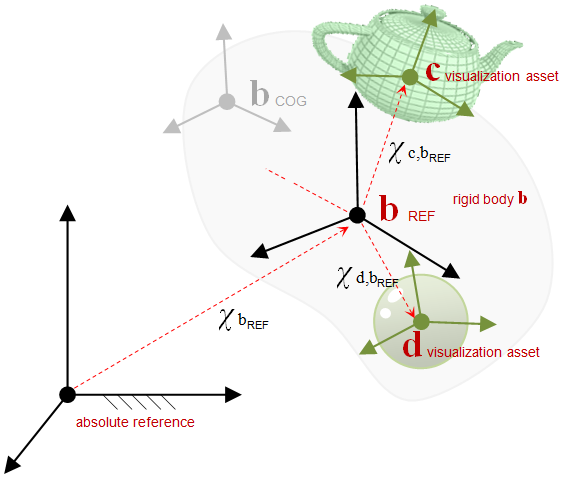Visualization assets represent optional objects that can be attached to rigid bodies for visualization purposes.
The Chrono visualization system allows defining visualization models, shapes, and materials. Various concrete implementations are available (e.g., based on Irrlicht or OpenGL) and a new system based on VulkanSceneGraph (VSG) ius under development.
Chrono is rendering engine agnostic. Indeed, if the IRRLICHT module is used, it is up to the Irrlicht module to convert the visualization assets into something that it can render. Likewise, if the POSTPROCESS module is used instead, this unit is expected to convert the visualization assets into scripts with shapes for the POVray rendering tool.
Once a visualization system was constructed, a Chrono system can be attached to it for run-time or postprocess rendering.
The main components of a visualization system are as follows:
- A visualization material (chrono::ChVisualMaterial) defines colors (diffuse, ambient, specular, and emissive), textures, and other related properties.
- A visualization shape (chrono::ChVisualShape) is a geometric shape (primitive, curve, surface, or triangular mesh) with one or more associated visualization materials. If a shape has no associated material, a default material is used.
- A visualization model (chrono::ChVisualModel) is an aggregate of (pointers to) shapes and a transform which specifies the shape position relative to the model reference frame. Visualization shapes in a model are maintained in a vector of
ShapeInstance(which is simply a typedef for a pair containing a shared pointer to aChVisualShapeand aChFrame). Note that, currently a visualization model instance cannot be placed inside another visualization model, but that may be added in the future. - A visualization model instance (chrono::ChVisualModelInstance) is a reference to a visualization model with an associated physics item. A physics item may have an associated visualization model instance.
chrono::ChVisualSystem defines a base class for possible concrete run-time visualization systems and imposes minimal common functionality. A ChSystem is attached to a visual system using ChVisualSystem::AttachSystem. The Chrono physics system will then trigger automatic updates to the visualization system as needed, depending on the particular type of analysis being conducted. The visualization system is set up in such a way that derived classes may allow simultaneous rendering of multiple Chrono systems; currently only ChVisualSystemOpenGL supports this feature.
Visualization models
The mechanism for defining visualization shapes and materials for a Chrono physics item is illkustrated in the following snippet:
Visualization shapes
There are many ready-to-use assets that define visualization shapes. Note that multiple visualization shapes can be attached to one visualization model.
Visualization assets are inherited from a base class called ChVisualShape. See chrono::ChVisualShape for API details.
Each shape has a translation and a rotation defined with respect to the reference frame of its owner visual model. The visual model is then attached to the owner body by specifying a translation and rotation relative to the REF body frame (note that this is not the COG frame, as shown in the figure below).

Examples of visualization assets:
- chrono::ChSphereShape
- chrono::ChBoxShape
- chrono::ChCylinderShape
- chrono::ChEllipsoidShape
- chrono::ChConeShape
- chrono::ChCapsuleShape
See demo_irr_assets for examples of defining various visual shapes associated with bodies in a Chrono system.
